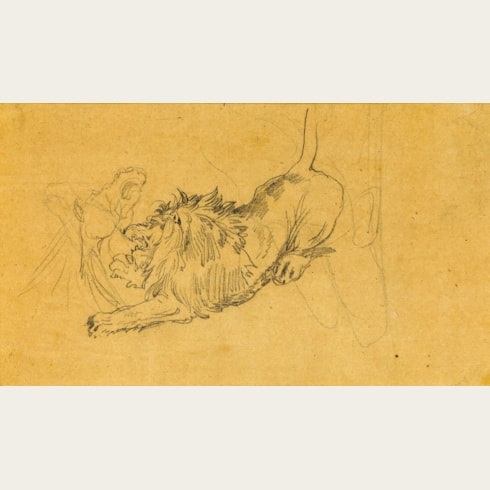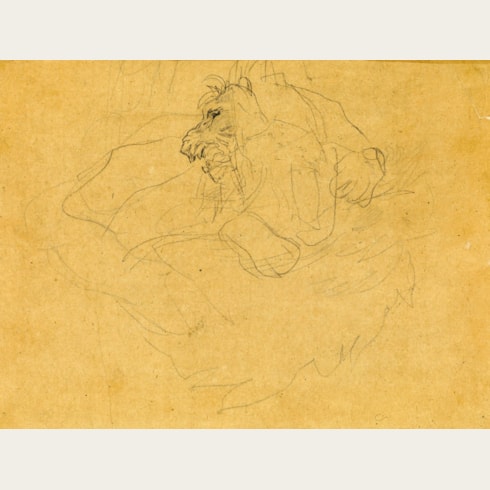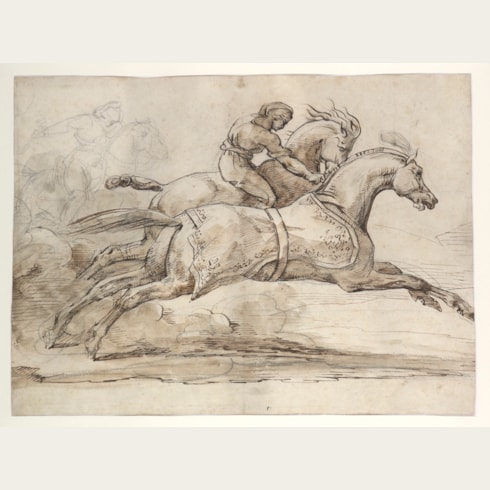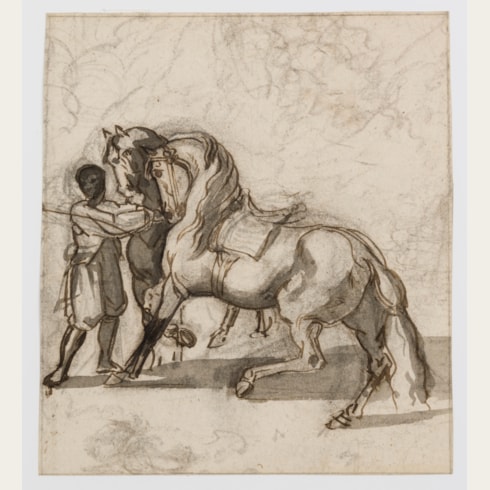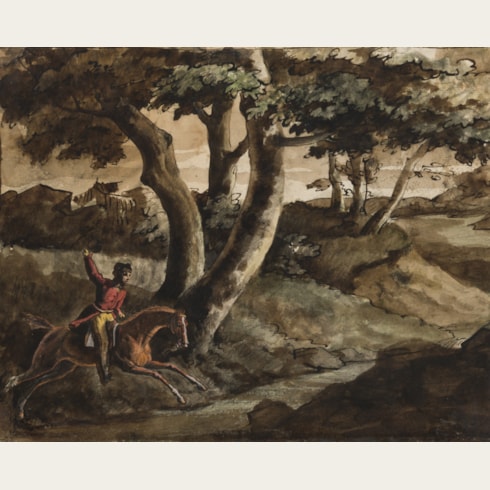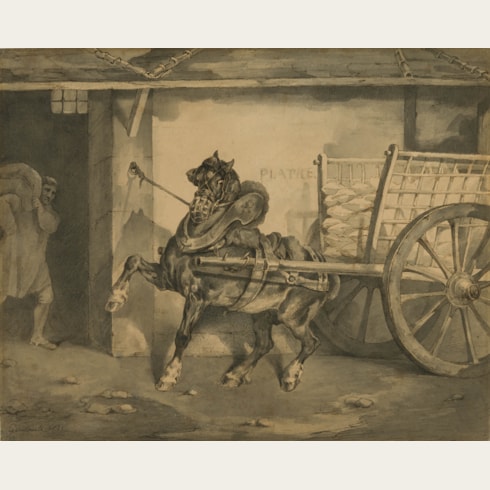Théodore GERICAULT
(Rouen 1791 - Paris 1824)
A Wild Horse Rearing, Held by a Groom
198 x 256 mm. (7 3/4 x 10 1/8 in.)
The present sheet may be included among a group of drawings and oil sketches by Géricault relating to the most important project of his Roman years; a monumental painting depicting The Start of the Race of the Barberi Horses. Géricault seems in particular to have been drawn to the periods just before the start of the race (known as ‘la mossa’), when young grooms would try to restrain the horses behind the starting rope, and at the end of the course, known as ‘la ripresa’, when the grooms would attempt to recapture the stampeding horses.
When working out his myriad ideas for the Race of the Barberi Horses on paper, Géricault tried out many different solutions to the question of how best to depict the frenzied scene of wild horses and their attendants at the start of the race. (The starting rope is indicated in this drawing, below the horse’s front hooves.) As the Géricault scholar Wheelock Whitney has pointed out, ‘[Another] motif that characterizes the early phase of the final “start” composition…is that of the ramping horse at the right, its forelegs poised over the starting rope. Although this horse continues to appear in every successive compositional study in the series…Géricault’s original idea seems to have been to depict the animal without the figure of a youth shown running alongside in later versions, but instead to leave the long, powerful flank of the animal fully exposed to view. In this presentation…the only brake on the horse’s forward motion is provided by the figure barely indicated behind it, who seems to restrain the horse by the head.’
This black chalk study is one of the finest drawings of the particular type noted by Whitney. As another Géricault scholar, Philippe Grunchec, has written of the present sheet, ‘This is a study of a Roman groom holding back a horse before the start of a race...At this stage in his planned composition, Gericault displays all his remarkable knowledge of horses: forelegs raised and poised to plunge past the rope, neck arched – for the groom has a strong hold – ears pinned back angrily, eyes bulging, hind legs bent under its weight in the horse’s effort to strain forward…every detail has been accurately noted and recorded by a true horseman.’
Also referring to the present sheet, Whitney writes that ‘A black chalk study of [a] horse and its groom, now in a private collection, vividly demonstrates Géricault’s profound knowledge and appreciation of the equine anatomy as well as his superb graphic powers. (What other French artist working in 1817, apart from Ingres, and perhaps Prud’hon, could have produced a drawing of this quality?). This drawing is clear evidence that at this point in the project he had by no means abandoned the idea of depicting the scene of the start of the race as the modern event he had witnessed in the Piazza del Popolo. Not only is the figure fully dressed in contemporary clothing, but the horse is shown with its tail knotted and wearing a halter, by which the groom restrains it, descriptive touches that plant the image even more firmly in the world of observed reality.’
A related, small-scale chalk study by Géricault of the same rearing horse in profile is today in the collection of Roberta J. M. Olson and Alexander B. V. Johnson in New York, while an identical horse and groom appear as part of a larger composition in a chalk drawing in a private collection. The same group appears as one of three sketches of horses on one sheet in another private collection, as well as in a pen and ink compositional study in the Musée des Beaux-Arts in Bayonne. In later, more developed treatments of the start of the race - such as an oil sketch in the J. Paul Getty Museum in Los Angeles and the most fully realized version of the subject, an oil sketch in the Louvre - the same horse remains at the right of the composition, though with a groom in front of the animal rather than behind.
The first recorded owner of the present sheet was the noted French financier and art collector Baron Joseph Vitta (1860-1942). Vitta’s collection included large and significant groups of works by Eugène Delacroix, Jules Chéret and Auguste Rodin, as well as important works by Albert Besnard, Félix Bracquemond, Jean-Auguste-Dominique Ingres and others. Sales of paintings and drawings from Vitta’s collection were held in Paris in 1924 and 1926, when this drawing was sold, and again in 1935.
The present sheet then entered the exceptional collection of paintings and drawings by Gericault assembled by the artist and art historian Pierre Olivier Dubaut (1886-1968). As an artist, Dubaut produced paintings, watercolours and prints of horses and equestrian subjects. He was especially fond of the work of Géricault, and organized several important exhibitions of his work. He had planned to publish a catalogue of the artist’s work, in collaboration with the Duc de Trévise, but this never came to fruition. Dubaut also owned works by Delacroix, Richard Parkes Bonington and Jacques-Louis David, among others.
Provenance
His sale, Paris, Hôtel Drouot, 27 May 1926, lot 118 (as attributed to Gericault: Cheval nu tenu en main, se cabrant. Crayon noir. H. 200 – L. 255.)
Pierre Olivier Dubaut, Paris (Lugt 2103b)
Thence by descent to a private collection in Paris, until 2011
Anonymous sale, Paris, Artcurial, 30 March 2011, lot 96
Arturo Cuéllar-Nathan, Zurich
Anonymous sale (‘Property of a Swiss Family’), London, Christie’s, 5 July 2017, lot 78.
Literature
Exhibition






